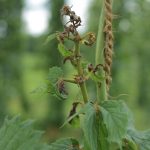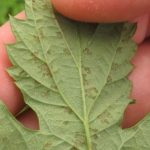As you know from previous What’s Hoppening posts, the first signs that a plant is infected with downy mildew will be basal spikes. But these are not the only symptoms of downy mildew.

As the season progresses, aerial spikes and infected leaves will begin to appear. Like basal spikes, aerial spikes are indicative of systemic plant infection. Aerial spikes have similar features to basal spikes, except they’re found on your trained plant rather than on the ground! Both side arms and the main bine may become aerial spikes if they are infected with downy mildew. Aerial spikes have the same chlorotic appearance and short internodes as basal spikes. If an aerial spike is a trained bine, it will stop growing and fall off its string. It is important to remove these infected bines and train only healthy shoots to produce the highest yielding crop and keep downy mildew from spreading to uninfected plant material.

Leaves may also be infected with downy mildew and are an indication of in-season infection. When downy mildew infects a leaf, it creates necrotic lesions, delineated by leaf veins. These lesions are angular and have very distinct edges, which can help with disease identification. Leaf lesions may also be covered in spores after wet periods, so be careful handling these leaves to reduce the risk of spreading infection.
Downy mildew can be a tough pathogen to fight, but there are options. Increasing air flow is a simple and straightforward cultural control. By maximizing the breeze in your hopyard, you can reduce the amount of time your foliage spends wet; this decreases the time that downy mildew is producing spores. Stripping the lower 2 to 4 feet of foliage once a plant is trained and established can reduce moisture, as well as keeping weed biomass low and driverows mowed.
During the season, fungicides are your friend. In wet weather, you should be prepared and ready to spray biofungicides during the day prior to an expected rain event. There are a variety of conventional and organic fungicides registered for hop use. If you live in Vermont, a list of OMRI-approved biofungicides can be found in the 2016 Hop Biofungicide Trial Research Report. It is very important to only apply fungicides that are listed in your state for use on hops so be sure to check the label.
For more information on downy mildew in hops, check out a recording of our webinar with plant pathologist David Gent and/or visit the resources on our website. Until next time, keep calm and hop on.